Mitigating Stress Corrosion Cracking of 304L and 316L Laser Welds in a Salt Spray through Micro-Shot Peening
Abstract
:1. Introduction
2. Materials and Experimental Procedures
3. Results
3.1. Macro-Views of the Tested Samples
3.2. XRD Spectrums of the Cold-Rolled Samples with and without MSP
3.3. The Micro-Hardness Profiles of the Shot-Peened Welds
3.4. Surface Appearance of the Tested Samples after Salt Spray
3.5. XRD Analysis of Residual Stress in the Cold-Rolled Plates
3.6. EBSD Analysis of the U-Bend Welds
4. Discussion
5. Conclusions
- With a 10% reduction in thickness after cold rolling, even the 304R sample showed slight strain hardening and a phase transformation. However, the induced residual tensile stress after cold rolling increased the pitting corrosion and SCC susceptibility of the ASS plates. The results indicated that MSP reversed the residual stress profiles of the cold-rolled plates, which improved the pitting corrosion and SCC resistance. Severe rusting in the 304R sample was seen after salt spraying, and it showed granular-like cracks inter-dispersed with coarse corrosion pits. After MSP, the corroded surface of the peened 304R sample showed distinct dent sizes inter-dispersed with numerous microcracks.
- Without MSP, the FB of the 304RW sample consisted of aligned corrosion pits, whereas uneven sizes of corrosion pits also damaged the FZ. With MSP, numerous fine dents and pits were found around the FB of the 304RWSP sample after salt spraying. EBSD analysis displayed that the peened FZ surface of the 304RWSP sample was covered with dense but thin α′-martensite, which increased the SCC susceptibility. However, the refined microstructure and high compressive residual stress in the FZ of the 304RWSP sample were beneficial in impeding the initiation of pitting corrosion and SCC. Moreover, the impact dents formed on the peened 316RW (316RWSP) surface after salt spraying were still visible in distinct zones, which implied better resistance to pitting corrosion and SCC.
- The presence of high compressive residual stress and the fine-grained structure in the peened ASS weld could increase the pitting corrosion resistance and decrease the SCC susceptibility. However, shot peening enhanced the martensitic transformation of the unstable ASS and increased surface roughness, which were harmful to the corrosion performance. The results indicated that MSP could lower the pitting corrosion and SCC susceptibility of an ASS weld. Based on the material essential, the better reliability and longer service life of dry storage canisters could be achieved using 316L SS for the construction and application of MSP.
Author Contributions
Funding
Data Availability Statement
Acknowledgments
Conflicts of Interest
References
- Dong, P.; Scatigno, G.G.; Wenman, M.R. Effect of Salt Composition and Microstructure on Stress Corrosion Cracking of 316L Austenitic Stainless Steel for Dry Storage Canisters. J. Nucl. Mater. 2021, 545, 152572. [Google Scholar] [CrossRef]
- Vehovar, L.; Tandler, M. Stainless steel containers for the storage of low and medium level radioactive waste. Nucl. Eng. Des. 2001, 206, 21–23. [Google Scholar] [CrossRef]
- Kain, V.; Sengupta, P.; De, P.K.; Banerjee, S. Case reviews on the effect of microstructure on the corrosion behavior of austenitic alloys for processing and storage of nuclear waste. Metall. Mater. Trans. A 2005, 36, 1075–1084. [Google Scholar] [CrossRef]
- Kim, S.; Kim, G.; Oh, C.Y.; Song, S. Pitting and Localized Galvanic Corrosion Characteristics of Gas Tungsten Arc Welded Austenitic Stainless Steel. Met. Mater. Int. 2022, 28, 2448–2461. [Google Scholar] [CrossRef]
- Acharyya, S.G.; Khandelwal, A.; Kain, V.; Kumar, A.; Samajdar, I. Surface working of 304L stainless steel: Impact on microstructure, electrochemical behavior and SCG resistance. Mater. Charact. 2012, 72, 68–76. [Google Scholar] [CrossRef]
- Zhang, W.; Wang, X.; Hu, Y.; Wang, S. Quantitative Studies of Machining-Induced Microstructure Alteration and Plastic Deformation in AISI 316 Stainless Steel Using EBSD. J. Mater. Eng. Perform. 2018, 27, 434–446. [Google Scholar] [CrossRef]
- Tsay, L.W.; Lin, Y.J.; Chen, C. The effects of rolling temperature and sensitization treatment on the sulfide stress corrosion cracking of 304L stainless steel. Corros. Sci. 2012, 63, 267–274. [Google Scholar] [CrossRef]
- Odnobokova, M.; Belyakov, A.; Enikeev, N.; Kaibyshev, R.; Valiev, R.Z. Microstructural Changes and Strengthening of Austenitic Stainless Steels during Rolling at 473 K. Metals 2020, 12, 1614. [Google Scholar] [CrossRef]
- Katsuyama, J.; Tobita, T.; Itoh, H.; Onizawa, K. Effect of Welding Conditions on Residual Stress and Stress Corrosion Cracking Behavior at Butt-Welding Joints of Stainless Steel Pipes. J. Press. Vessel Technol. 2012, 134, 021403. [Google Scholar] [CrossRef]
- Wu, X. On residual stress analysis and microstructural evolution for stainless steel type 304 spent nuclear fuel canisters weld joint: Numerical and experimental studies. J. Nucl. Mater. 2020, 534, 152131. [Google Scholar] [CrossRef]
- He, S.; Jiang, D. Effect of the Degree of Rolling Reduction on the Stress Corrosion Cracking Behavior of SUS 304 Stainless Steel. Int. J. Electrochem. Sci. 2018, 13, 1614–1628. [Google Scholar] [CrossRef]
- Solomon, N.; Solomon, I. Effect of deformation-induced phase transformation on AISI 316 stainless steel corrosion resistance. Eng. Fail Anal. 2017, 79, 865–875. [Google Scholar] [CrossRef]
- Park, I.; Kim, E.Y.; Yang, W.J. Microstructural Investigation of Stress Corrosion Cracking in Cold-Formed AISI 304 Reactor. Metals 2021, 11, 7. [Google Scholar] [CrossRef]
- Ghosh, S.; Kain, V. Effect of surface machining and cold working on the ambient temperature chloride stress corrosion cracking susceptibility of AISI 304L stainless steel. Mater. Sci. Eng. A 2010, 527, 679–683. [Google Scholar] [CrossRef]
- Kain, V.; Chandra, K.; Adhe, K.N.; De, P.K. Effect of cold work on low-temperature sensitization behaviour of austenitic stainless steels. J. Nucl. Mater. 2004, 334, 115–132. [Google Scholar] [CrossRef]
- Singh, R. Influence of cold rolling on sensitization and intergranular stress corrosion cracking of AISI 304 aged at 500 °C. J. Mater. Process. Technol. 2008, 206, 286–293. [Google Scholar] [CrossRef]
- Li, W.J.; Young, M.C.; Lai, C.L.; Kai, W.; Tsay, L.W. The effects of rolling and sensitization treatments on the stress corrosion cracking of 304L stainless steel in salt-spray environment. Corros. Sci. 2013, 68, 25–33. [Google Scholar] [CrossRef]
- Lu, Z.; Xu, F.; Tang, C.; Cui, Y.; Xu, H.; Mao, J. Stress Corrosion Cracking Susceptibility of 304 Stainless Steel Subjected to Laser Shock Peening without Coating. J. Mater. Eng. Perform. 2021, 30, 7163–7170. [Google Scholar] [CrossRef]
- Liu, H.; Wei, Y.; Tan, C.K.I.; Ardi, D.T.; Tan, D.C.C.; Lee, C.J.J. XRD and EBSD studies of severe shot peening induced martensite transformation and grain refinements in austenitic stainless steel. Mater. Charact. 2020, 168, 110574. [Google Scholar] [CrossRef]
- Ye, C.; Telang, A.; Gill, A.; Wen, X.; Mannava, S.R.; Qian, D.; Vasudevan, V.K. Effects of Ultrasonic Nanocrystal Surface Modification on the Residual Stress, Microstructure, and Corrosion Resistance of 304 Stainless Steel Welds. Metall. Mater. Trans. A 2018, 49, 972–978. [Google Scholar] [CrossRef]
- Amanov, A.; Karimbaev, R.; Maleki, E.; Unal, O.; Pyun, Y.-S.; Amanov, T. Effect of combined shot peening and ultrasonic nanocrystal surface modification processes on the fatigue performance of AISI 304. Surf. Coat. Technol. 2019, 358, 695–705. [Google Scholar] [CrossRef]
- Lu, J.Z.; Luo, K.Y.; Yang, D.K.; Cheng, X.N.; Hu, J.L.; Dai, F.Z.; Qi, H.; Zhang, L.; Zhong, J.S.; Wang, Q.W.; et al. Effects of laser peening on stress corrosion cracking (SCC) of ANSI 304 austenitic stainless steel. Corros. Sci. 2012, 60, 145–152. [Google Scholar] [CrossRef]
- Yoo, Y.; Yan, X.; Wang, F.; Zhu, Q.; Lu, Y.; Cui, B. Mechanisms of Mitigating Chloride-Induced Stress Corrosion Cracking of Austenitic Steels by Laser Shock Peening. Corrosion 2022, 78, 494–502. [Google Scholar] [CrossRef] [PubMed]
- Sundar, R.; Ganesh, P.; Kumar, B.S.; Gupta, R.K.; Nagpure, D.C.; Kaul, R.; Ranganathan, K.; Bindra, K.S.; Kain, V.; Oak, S.M.; et al. Mitigation of Stress Corrosion Cracking Susceptibility of Machined 304L Stainless Steel Through Laser Peening. J. Mater. Eng. Perform. 2016, 25, 3710–3724. [Google Scholar] [CrossRef]
- Naito, A.; Takakuwa, O.; Soyama, H. Development of peening technique using recirculating shot accelerated by water jet. Mater. Sci. Technol. 2012, 28, 234–239. [Google Scholar] [CrossRef]
- Wei, X.; Zhu, D.; Ling, X.; Yu, L.; Dai, M. Influence of Wet Micro-Shot Peening on Surface Properties and Corrosion Resistance of AISI 304 Stainless Steel. Int. J. Electrochem. Sci. 2018, 13, 4198–4207. [Google Scholar] [CrossRef]
- Dong, L.; Zhang, X.; Han, Y.; Peng, Q.; Deng, P.; Wang, S. Effect of surface treatments on microstructure and stress corrosion cracking behavior of 308L weld metal in a primary pressurized water reactor environment. Corros. Sci. 2020, 166, 108465. [Google Scholar] [CrossRef]
- Lu, Z.; Shi, L.; Zhu, S.; Tang, Z.; Jiang, Y. Effect of high energy shot peening pressure on the stress corrosion cracking of the weld joint of 304 austenitic stainless steel. Mater. Sci. Eng. A 2015, 637, 170–174. [Google Scholar]
- Chen, X.; Li, Y.; Zhu, Y.; Bai, Y.; Yang, B. Improved corrosion resistance of 316LN stainless steel performed by rotationally accelerated shot peening. Appl. Surf. Sci. 2019, 481, 1305–1312. [Google Scholar] [CrossRef]
- Abdullah, A.; Malaki, M.; Eskandari, A. Strength enhancement of the welded structures by ultrasonic peening. Mater. Des. 2012, 38, 7–18. [Google Scholar] [CrossRef]
- Kang, C.Y.; Chen, T.C.; Tsay, L.W. Effects of Micro-Shot Peening on the Stress Corrosion Cracking of Austenitic Stainless Steel Welds. Metals 2023, 13, 69. [Google Scholar] [CrossRef]
- Hensel, J.; Eslami, H.; Nitschke-Pagel, T.; Dilger, K. Fatigue strength enhancement of butt welds by means of shot peening and clean blasting. Metals 2019, 9, 744. [Google Scholar] [CrossRef]
- Muñoz, J.A.; Dolgach, E.; Tartalini, V.; Risso, P.; Avalos, M.; Bolmaro, R.; Cabrera, J.M. Microstructural Heterogeneity and Mechanical Properties of a Welded Joint of an Austenitic Stainless Steel. Metals 2023, 13, 245. [Google Scholar] [CrossRef]
- Chung, Y.-H.; Chen, T.-C.; Lee, H.-B.; Tsay, L.-W. Effect of Micro-Shot Peening on the Fatigue Performance of AISI 304 Stainless Steel. Metals 2021, 11, 1408. [Google Scholar] [CrossRef]
- ASTM E290-97a; Standard Test Methods for Bend Testing of Material for Ductility. ASTM: West Conshohocken, PA, USA, 2004.
- Sharma, P.; Roy, H. Pitting corrosion failure of an AISI stainless steel pointer rod. Eng. Fail. Anal. 2014, 44, 400–407. [Google Scholar] [CrossRef]
- Lu, B.-T.; Chen, Z.-K.; Luo, J.-L.; Patchett, B.M.; Xu, Z.-H. Pitting and stress corrosion crack behavior in welded austenitic stainless steel. Electrochim. Acta 2005, 50, 1391–1403. [Google Scholar] [CrossRef]
- Franco, C.V.; Barbosa, R.P.; Martinelli, A.E.; Buschinelli, A.J.A. Study of the influence of welding parameters on the stress corrosion resistance of AISI 304 steel. Mater. Corro. 1998, 49, 496–504. [Google Scholar] [CrossRef]
- Lu, B.-T.; Chen, Z.-K.; Luo, J.-L.; Patchett, B.M.; Xu, Z.-H. Stress corrosion crack initiation and propagation in longitudinally welded 304 austenitic stainless steel. Corro. Eng. Sci. Technol. 2003, 38, 69–75. [Google Scholar]
- Kessal, B.A.; Fares, C.; Meliani, M.H.; Alhussein, A.; Bouledroua, O.; Francois, M. Effect of gas tungsten arc welding parameters on the corrosion resistance and the residual stress of heat affected zone. Eng. Fail. Anal. 2019, 107, 104200. [Google Scholar] [CrossRef]

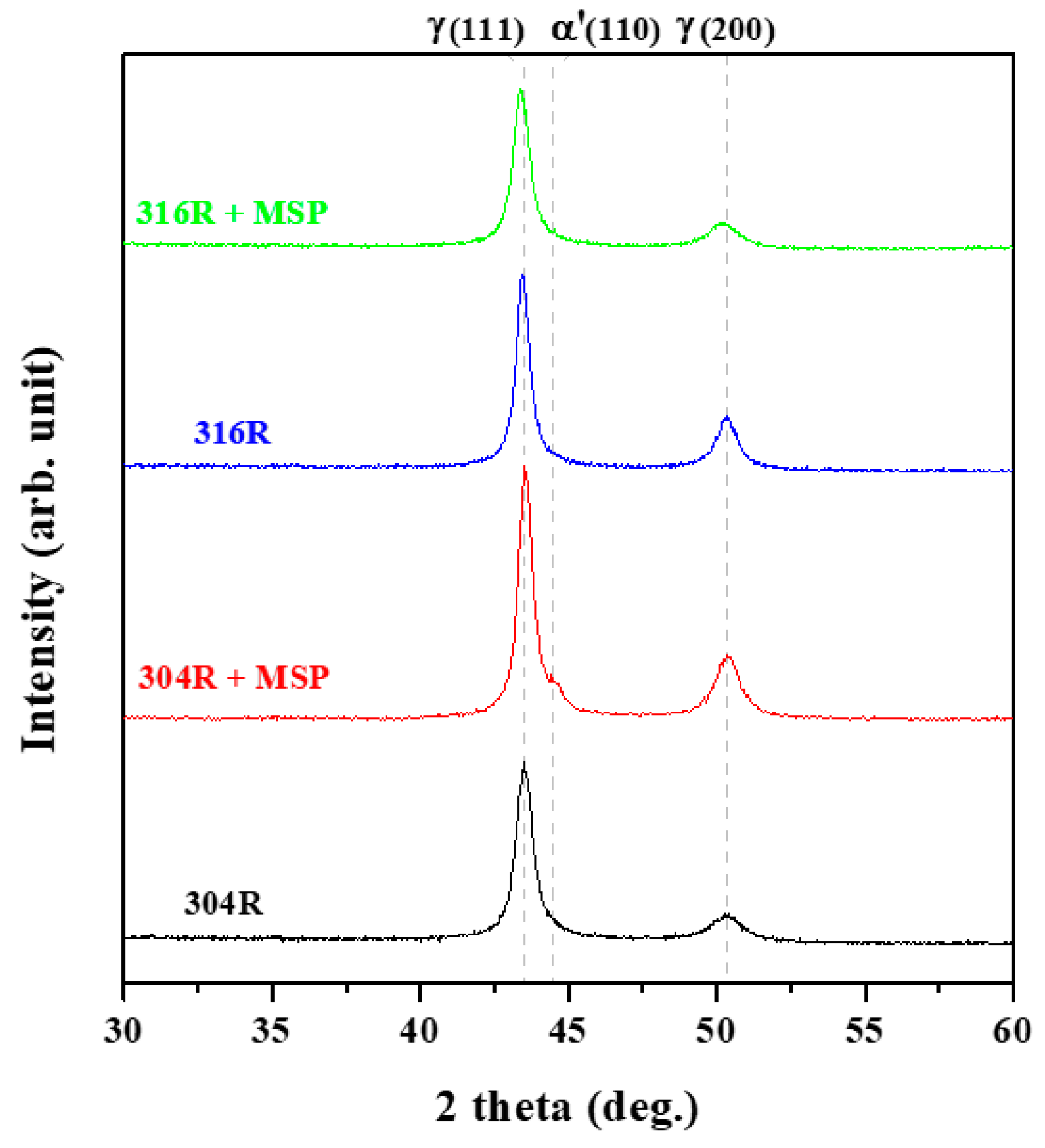

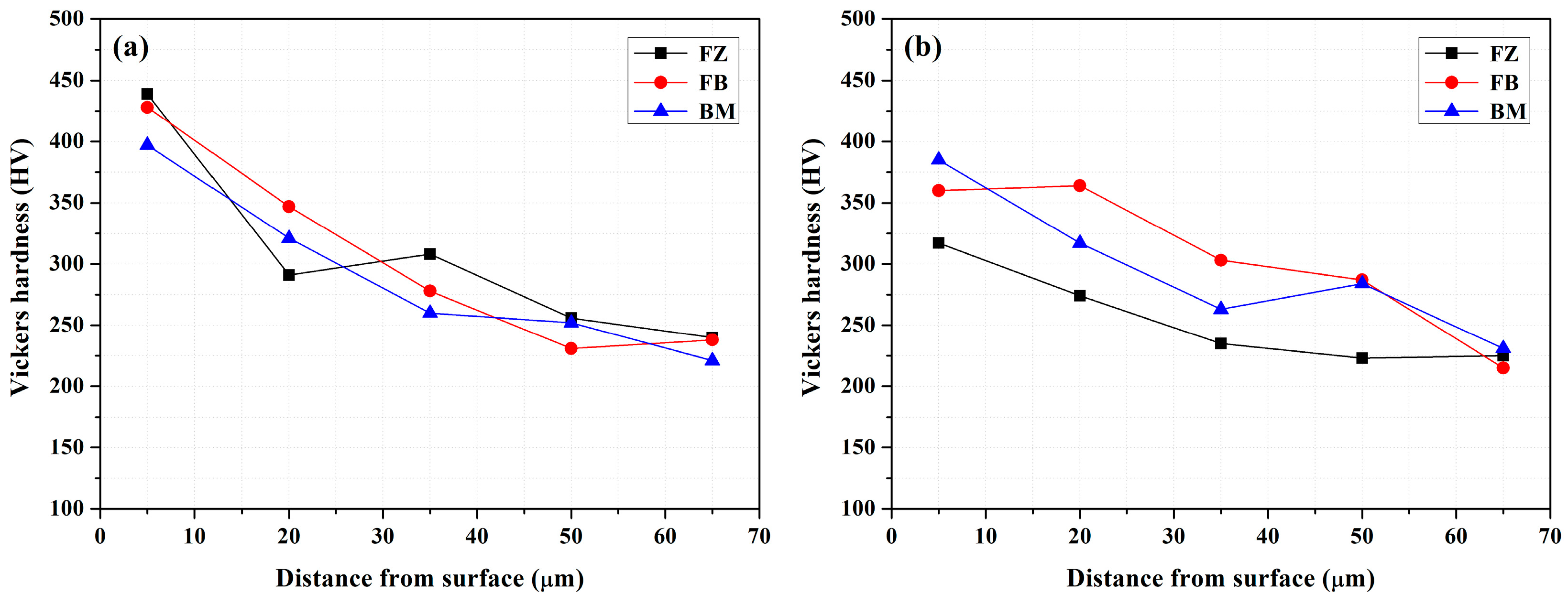

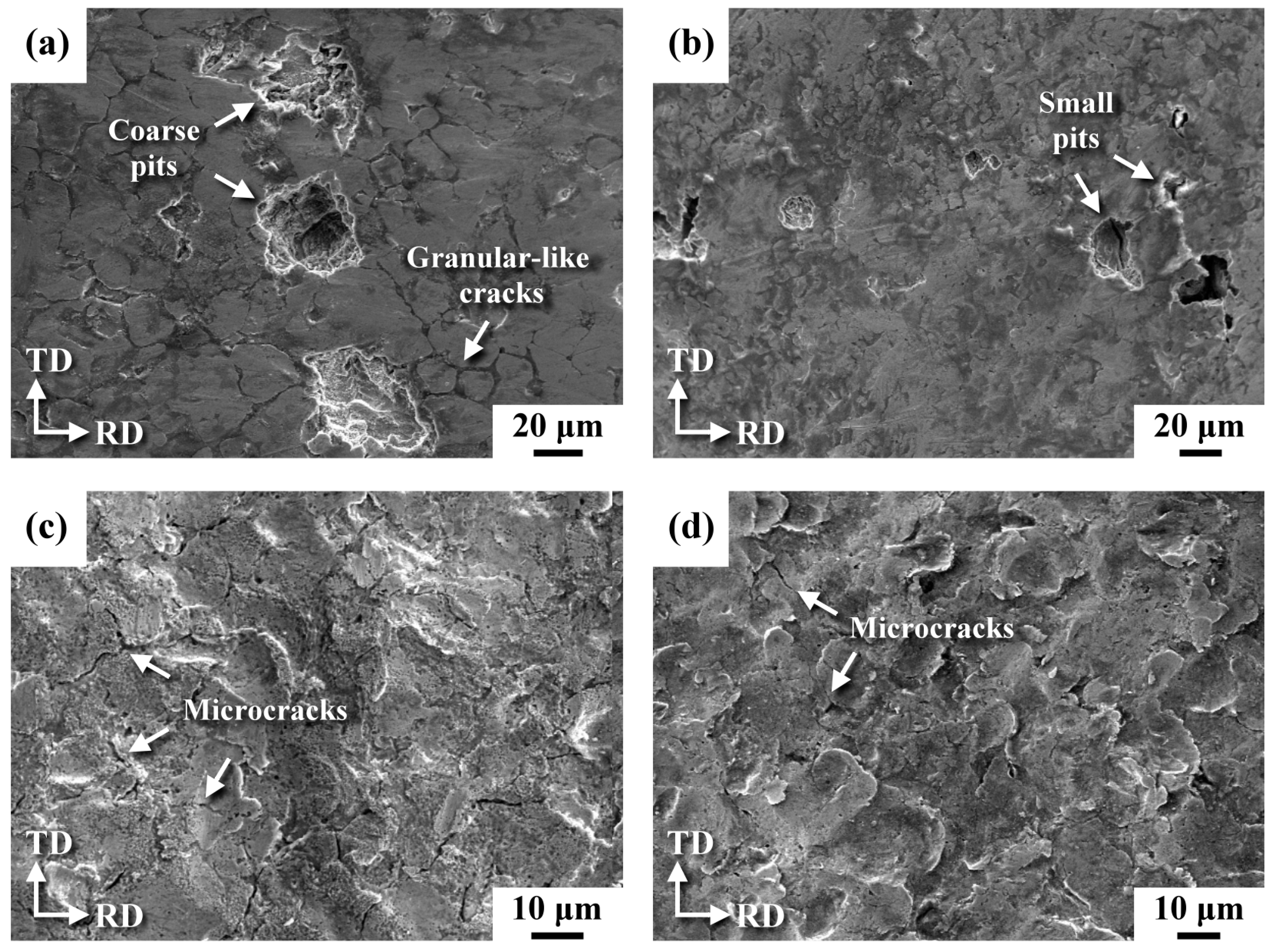
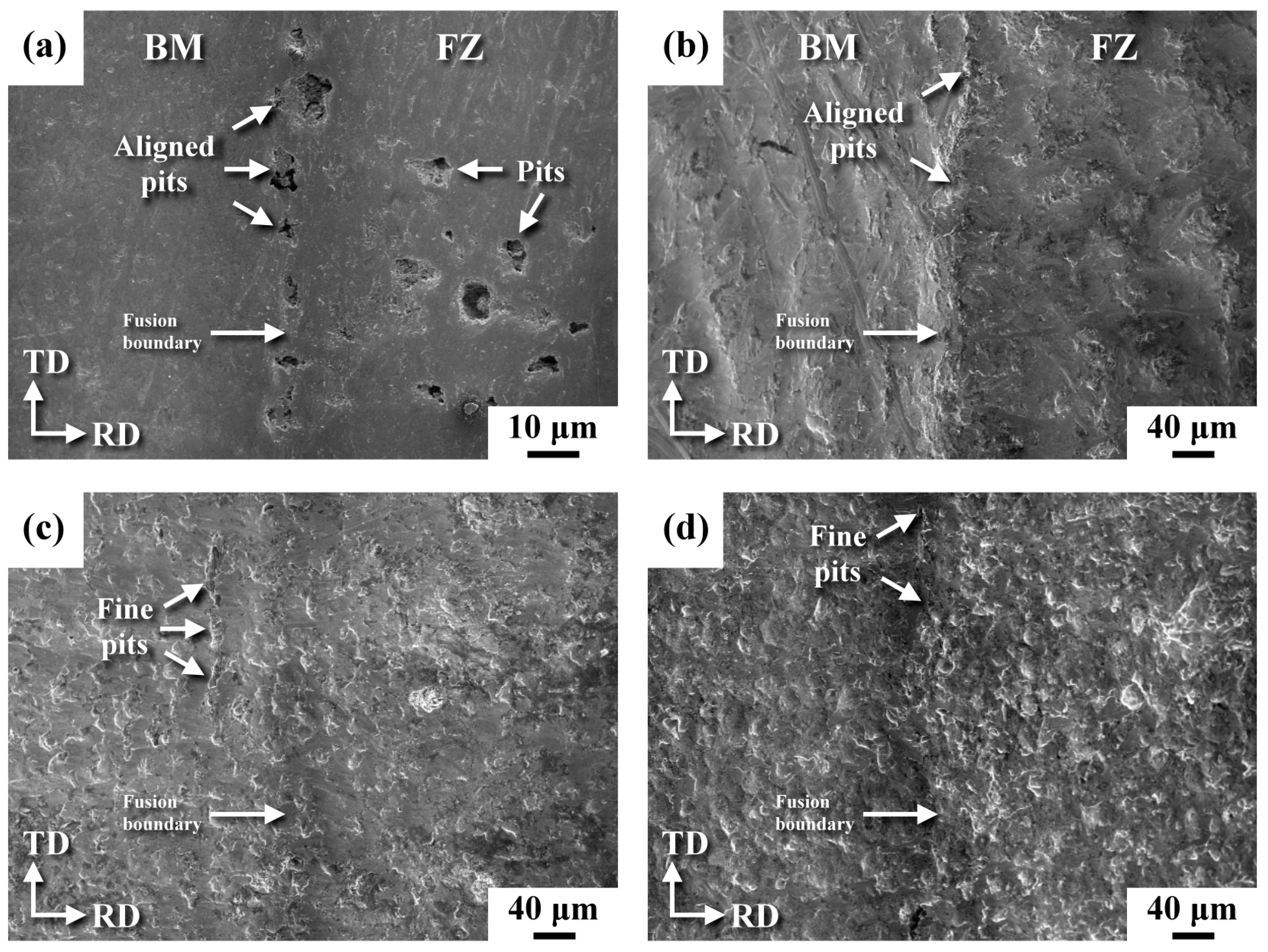
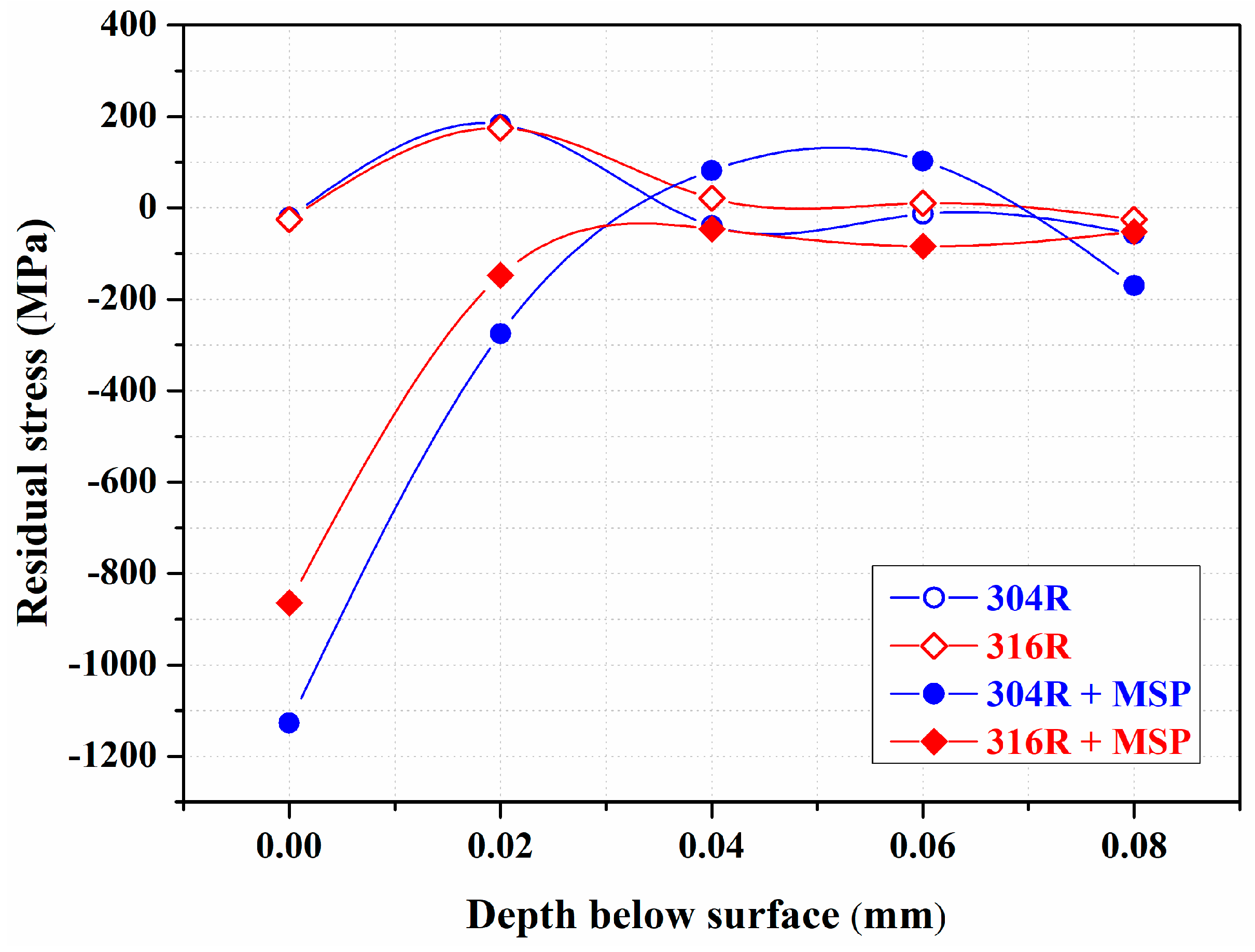
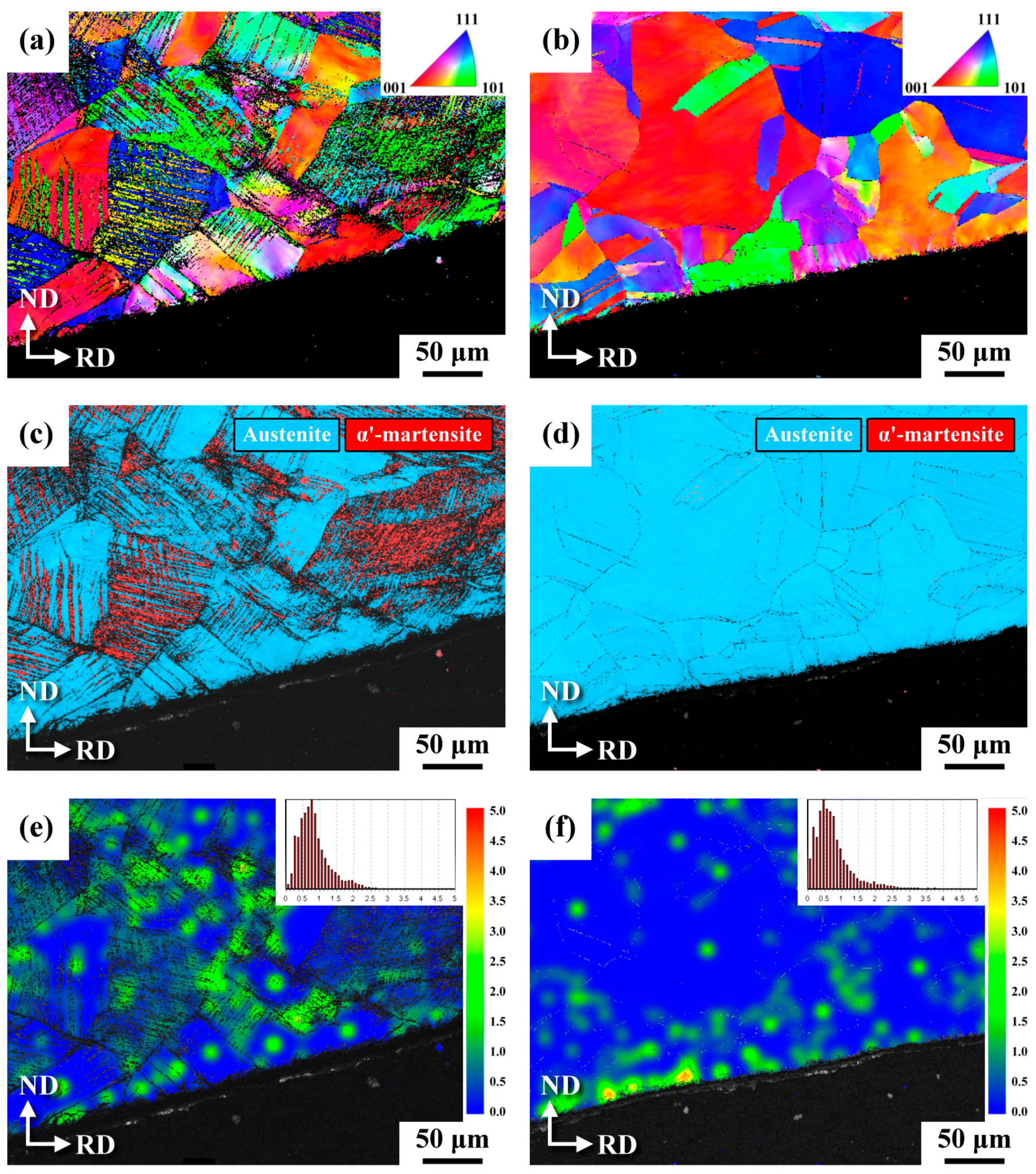

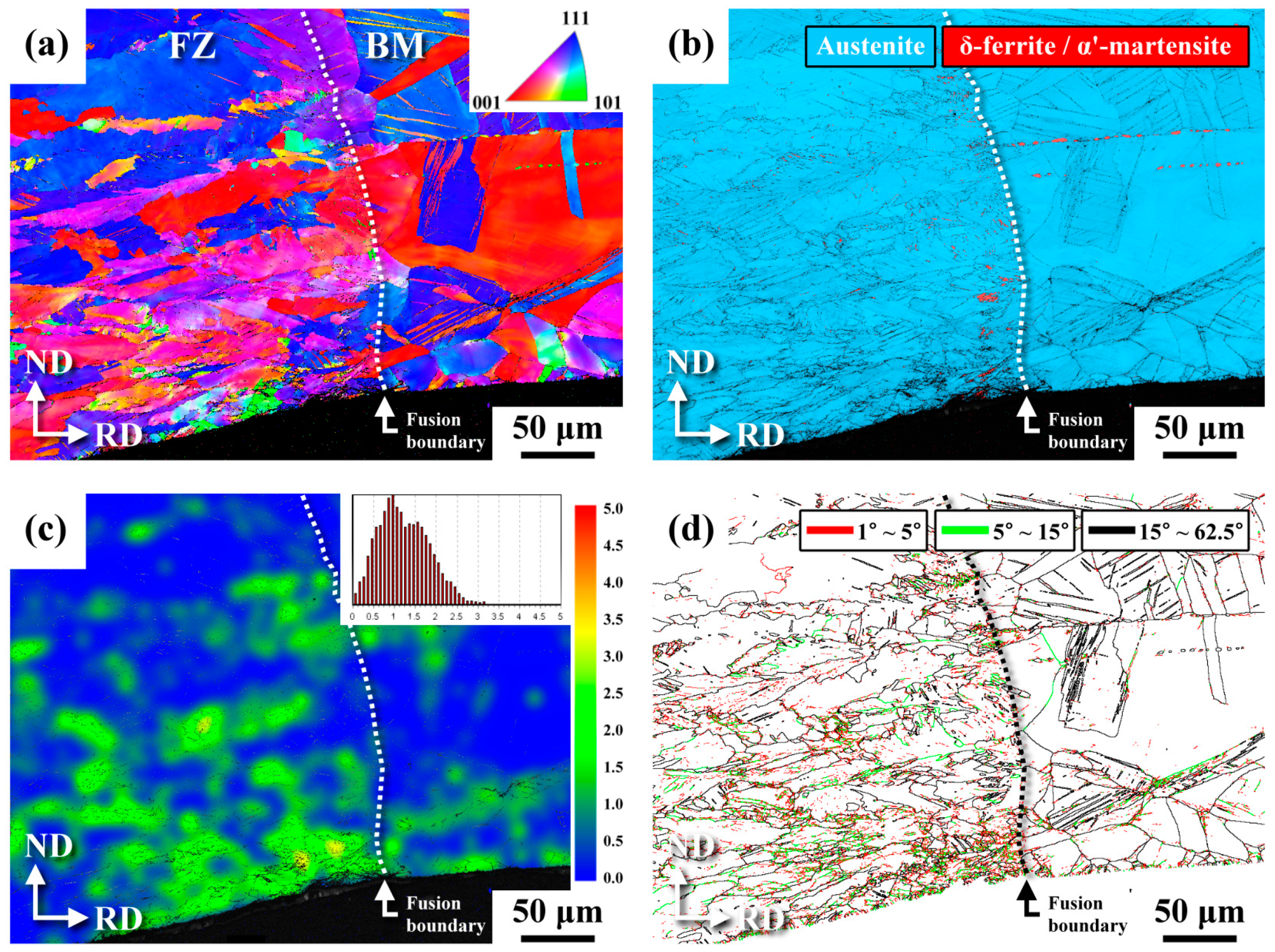
Disclaimer/Publisher’s Note: The statements, opinions and data contained in all publications are solely those of the individual author(s) and contributor(s) and not of MDPI and/or the editor(s). MDPI and/or the editor(s) disclaim responsibility for any injury to people or property resulting from any ideas, methods, instructions or products referred to in the content. |
© 2023 by the authors. Licensee MDPI, Basel, Switzerland. This article is an open access article distributed under the terms and conditions of the Creative Commons Attribution (CC BY) license (https://creativecommons.org/licenses/by/4.0/).
Share and Cite
Kang, C.-Y.; Chen, T.-C.; Shiue, R.-K.; Tsay, L.-W. Mitigating Stress Corrosion Cracking of 304L and 316L Laser Welds in a Salt Spray through Micro-Shot Peening. Metals 2023, 13, 1898. https://doi.org/10.3390/met13111898
Kang C-Y, Chen T-C, Shiue R-K, Tsay L-W. Mitigating Stress Corrosion Cracking of 304L and 316L Laser Welds in a Salt Spray through Micro-Shot Peening. Metals. 2023; 13(11):1898. https://doi.org/10.3390/met13111898
Chicago/Turabian StyleKang, Chia-Ying, Tai-Cheng Chen, Ren-Kae Shiue, and Leu-Wen Tsay. 2023. "Mitigating Stress Corrosion Cracking of 304L and 316L Laser Welds in a Salt Spray through Micro-Shot Peening" Metals 13, no. 11: 1898. https://doi.org/10.3390/met13111898
APA StyleKang, C.-Y., Chen, T.-C., Shiue, R.-K., & Tsay, L.-W. (2023). Mitigating Stress Corrosion Cracking of 304L and 316L Laser Welds in a Salt Spray through Micro-Shot Peening. Metals, 13(11), 1898. https://doi.org/10.3390/met13111898









